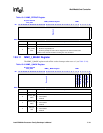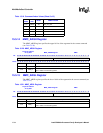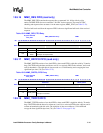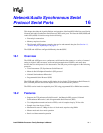
Intel® PXA26x Processor Family Developer’s Manual 16-1
Network/Audio Synchronous Serial
Protocol Serial Ports 16
This chapter describes the signal definitions and operation of the Intel® PXA26x Processor Family
Network and Audio Synchronous Serial Protocol (SSP) serial ports. The Network SSP (NSSP) and
Audio SSP (ASSP) are similar except for the following:
• External pin connections
• Memory map base location
• The Network ASSP supports swapping the receive and transmit data pins. See Section 4.1,
“General-Purpose Input/Output” on page 4-1.
The NSSP and ASSP are configured differently than the SSPC.
16.1 Overview
The NSSP and ASSP ports are a synchronous serial interface that connect to a variety of external
analog-to-digital (A/D) converters, audio and telecommunication CODECs, and many other
devices that use serial protocols for data transfer. The SSP ports provide support for the following
protocols:
• Texas Instruments (TI) Synchronous Serial Protocol*
• Motorola Serial Peripheral Interface* (SPI) protocol
• National Semiconductor Microwire*
• Programmable Serial Protocol (PSP)
The NSSP and ASSP ports operate as full-duplex devices for the TI Synchronous Serial Protocol*,
SPI*, and PSP protocols and as half-duplex devices for the Microwire* protocol.
The FIFOs can be loaded or emptied by the CPU using programmed I/O or DMA burst transfers.
16.2 Features
• Supports the TI Synchronous Serial Protocol*, the Motorola SPI* protocol, National
Semiconductor Microwire*, and a Programmable Serial Protocol (PSP)
• Two independent transmit and receive FIFOs, each 16 samples deep by 32-bits wide
• Sample sizes from four to 32-bits
• Maximum bit rate of 13 Mbps in slave of clock mode, requires using DMA
• Master-mode and slave-mode operation
• Receive-without-transmit operation


















